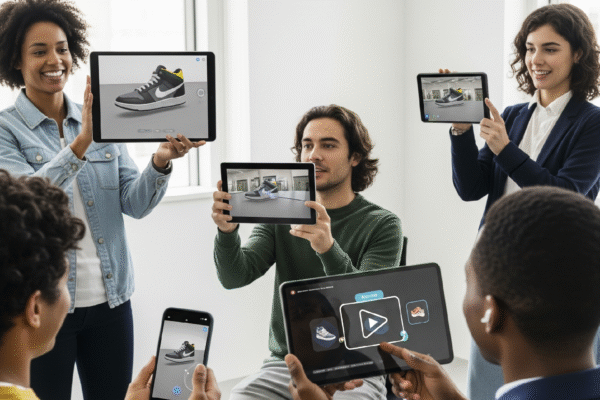
The Future of Search Is Here - Are You Ready?
In a world where we now ask instead of type and snap instead of search, the way people find information is shifting faster than most brands can keep up. The old rules of SEO no longer hold all the answers. If your business still relies only on traditional search optimization, you’re likely missing out on a major share of today’s most engaged consumers.
In 2025, voice and visual search are not just trends, they are revolutionizing how people interact with the web. From smart speakers to mobile cameras and AI search tools like Google Lens, consumers expect instant, intuitive answers to their needs.
But here’s the big question: How can you make your brand findable in a world where people don’t even type anymore?
Let’s dive into how voice and visual search work, why they matter now more than ever, and most importantly how you can optimize for them to stay relevant and rank on the first page of Google.
Part 1: The Rise of Voice Search – Why Talking Is the New Typing
We’re living in the golden age of digital assistants. Google Assistant, Alexa, Siri, and even in-car voice systems have become part of our daily lives.
The Numbers Speak Loudly:
- Over 58% of internet users globally used voice search at least once per week in early 2025.
- It’s estimated that 40% of all online searches in 2025 are voice-based.
- All over the world, the rise of affordable smartphones with Google Assistant has made voice search more mainstream than ever.
Voice search isn’t just a novelty, it’s becoming the default for busy, on-the-go consumers who want fast, hands-free answers.
What Makes Voice Search Different?
Unlike traditional search, voice queries are:
- Longer and more conversational
(“Where can I find a vegan bakery near me?” instead of “vegan bakery Minnesota”)- Often posed as questions
- More likely to be local and urgent
Voice Search Optimization Strategies for 2025
- Use Natural, Conversational Language in Your Content
People speak differently than they type. So, your content should reflect how real people talk.
Tip:
Create FAQ-style pages or blog posts that directly answer questions like:
- “How do I start a small business in Las Vegas?”
- “What’s the best digital marketing agency near me?”
Use tools like AnswerThePublic or AlsoAsked to find real voice-like queries.
- Optimize for Featured Snippets (Position Zero)
Google often pulls voice search answers directly from featured snippets. To increase your chances:
- Structure answers clearly using headings (H2/H3)
- Use bullet points and short, clear sentences
- Include the question in the heading and the answer immediately after
Example:
Q: What is visual search?
A: Visual search uses images, rather than text, as the input to find related content online…
- Focus on Local SEO
Over 50% of voice searches have local intent. Ensure:
- Your Google Business Profile is complete and updated
- Use local keywords (e.g., “digital agency in Seattle”)
- Include location pages if you serve multiple cities
- Improve Site Speed and Mobile Friendliness
Voice search often happens on mobile. If your site is slow or not mobile-friendly, Google won’t priorities you.
Use tools like Google PageSpeed Insights and Mobile-Friendly Test.
Part 2: Visual Search – When a Picture Becomes the Query
Visual search allows users to snap a photo or upload an image to find what they need—no keywords required.
Platforms like Google Lens, Pinterest Lens, Snapchat Scan, and Amazon StyleSnap are at the forefront. In Africa, where mobile-first culture dominates, visual search is rapidly gaining traction.
Real-Life Example:
Imagine someone sees a unique Patterned handbag at an event. Instead of asking, “What’s this called?” they snap a photo using Google Lens. Within seconds, they find similar products, prices, and even buy links.
If your product isn’t optimized for visual search? You lose the sale, just like that.
How to Optimize for Visual Search in 2025
- Use High-Quality, Original Images
Stock images don’t work well for visual search. Google and other tools rely on unique, clear, high-resolution visuals.
Upload original photos of:
- Products from multiple angles
- People using your services
- Close-up shots with neutral backgrounds
- Add Descriptive ALT Text (and Do It Properly)
ALT text isn’t just for accessibility. It helps search engines understand your images.
Instead of:
<img src=”bag.jpg” alt=”bag”>
Try:
<img src=”patterned-handbag.jpg” alt=”Handcrafted patterend print handbag with brown leather handle”>Use natural language, include relevant keywords, and be descriptive without keyword stuffing.
- Use Schema Markup for Images
Structured data helps Google understand context.
If you’re selling products, implement Product Schema with image, name, price, and reviews.
This improves your chance of being pulled into rich results and visual feeds.
- Create Visual Search-Friendly Content
Create blog posts and landing pages with image-first layouts. For example:
Post Title: “10 Trending Patterned Bags in Seattle Right Now”
Include unique images
Link to products
Use descriptive captions and filenamesThis makes your site more discoverable through tools like Google Lens and Pinterest.
The Power of Combining Voice & Visual Search
In many ways, voice and visual search are converging. Some mobile devices allow people to speak a command and show an image simultaneously.
Your optimization strategy should reflect this hybrid behavior.Real Scenario:
A user asks, “Show me modern office furniture near me,” and taps an image they like. Google presents a carousel of shops, prices, and contact details.
If your content combines:
- Local SEO
- Image-rich pages
- Clear product data
…You’ll be the one they choose.
Advanced Tips for Brands Who Want to Lead
Create Voice-Search-Ready Podcasts or Audio Blogs
Embed them on your site and transcribe them for SEO.Optimize Videos for Search Engines
Add descriptive titles, captions, and include a visual version of your post on YouTube or Instagram Reels.Use Google Search Console to Track Visual Performance
Check the Image tab to see which visuals are bringing traffic.Design with Visual First UX
Think “What would this page look like if someone found it through a photo or spoken query?”
Why This Matters More Than Ever
Search is becoming more human. We want instant results, relevant experiences, and intuitive interaction. If your brand doesn’t adapt to how people are searching now, you risk becoming invisible in the future.
But if you do adapt, if you speak their language (literally) and show up in their lens, you’ll build trust, visibility, and loyalty faster than ever before.
Your brand isn’t just a name.
It’s an answer. It’s a moment. It’s a tap, a swipe, a snap, or a question.
And now, it’s your time to be found.
Final Checklist: Are You Ready for 2025 Search?
My content uses natural, question-based language
My site loads fast and is mobile-friendly
I use structured data and descriptive ALT tags
My local SEO is fully set up and accurate
I include original, high-quality images
My brand is optimized for both voice and visual discovery
Want your brand to stand out in a voice-and-visual world?
Let Apical Creative Hub help you optimize for the future of search.
From content strategy to mobile UX and visual branding, we craft digital experiences that get you seen, heard, and remembered.Contact Us Today at:
ApicalCreativeHub.com




